Forbidden City - A structure of timeless beauty in China #part 1
The Forbidden City is the largest palace, a place that holds the history of China for many generations. This is also one of the largest and most classy architectural works in China. Join us to learn about history and architecture to have the best experience when visiting China.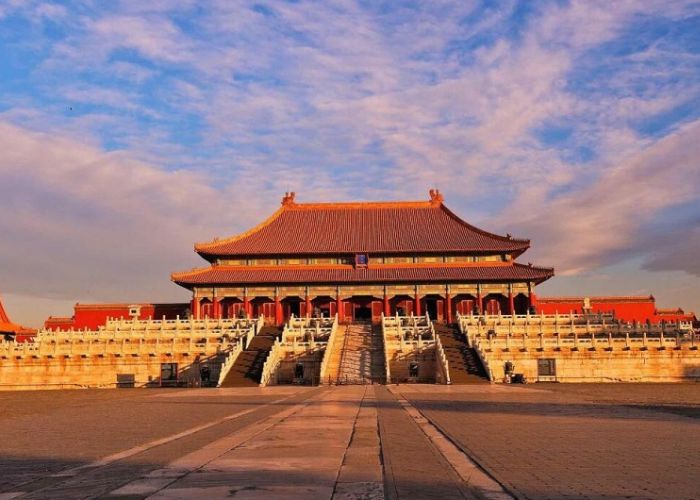 The Forbidden City is one of the famous tourist attractions and has extremely important historical value in Beijing, China. Built during the Ming Dynasty, the Forbidden City served as a residence for emperors and royal families for more than 500 years.
The Forbidden City is one of the famous tourist attractions and has extremely important historical value in Beijing, China. Built during the Ming Dynasty, the Forbidden City served as a residence for emperors and royal families for more than 500 years.
The Forbidden City has witnessed many changes and upheavals in Chinese history. It has served as the residence for the emperors and empresses of the Ming Dynasty and Qing Dynasty. In addition to being a royal palace, the Forbidden City also served as a center of power and national governance. Many important historical events have taken place here, including inauguration ceremonies, banquets and important press conferences.
The Forbidden City also houses many precious works of art and artifacts, including paintings, coins, imperial government, and other artifacts related to the Ming and Qing dynasties. This helps preserve and inspire China's culture.
This is a great and iconic architectural work, recognized by UNESCO as a World Cultural Heritage.
The Forbidden City, also known as the Imperial Palace, is a great architectural work located in the center of Beijing, China. The Forbidden City was built starting during the Ming Dynasty (1368-1644) and lasting through the Qing Dynasty (1644-1912) of China. Here is a detailed summary of the history of the Forbidden City:
In 1406, Emperor Zhu Di of the Ming Dynasty built a magnificent palace in Beijing. He wanted the Forbidden City to become a residence for the royal family and become the headquarters of the Ming dynasty. This is also the place where Zhu De wanted to demonstrate the power and strength of the Ming dynasty. Construction lasted between 1406 and 1420. Thousands of workers and laborers were involved in the project, including local residents and experts in architecture and art . The Forbidden City was built under the direction of leading architects and designers of the Ming Dynasty, creating a beautiful and sophisticated masterpiece of classical Chinese architecture.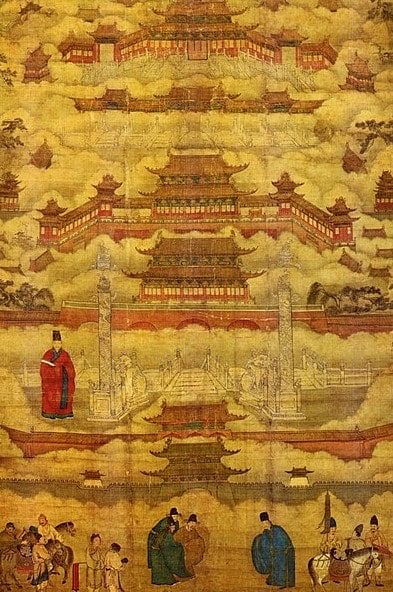 During the Ming Dynasty, the Forbidden City underwent growth and expansion with the construction of new structures and upgrading of existing structures. The palace became larger and more complex through different periods.
During the Ming Dynasty, the Forbidden City underwent growth and expansion with the construction of new structures and upgrading of existing structures. The palace became larger and more complex through different periods.
When the Qing Dynasty came to power in 1644, the Forbidden City continued to be used as a residence for the emperor and empress of this dynasty. New buildings and royal rooms were added, bringing richness and diversity to the Forbidden City.
The Forbidden City is a monumental palace structure located in the center of Beijing, China. This place is considered one of the greatest architectural wonders in the world. The architecture of the Forbidden City reflects the sophistication and balance in design, the ingenuity in the use of color and decorative elements, and creates a magnificent and traditional Chinese space.
The Forbidden City is rectangular in shape with a length of about 961 meters from the Central Palace to the Jiufen Gate and a width of about 753 meters from the East Gate to the West Gate. The Forbidden City was built according to the principle of "two pillars of eight levels" (a pair of eight-level pillars). The palace is surrounded by a thick wall with eight main gates and eight main buildings.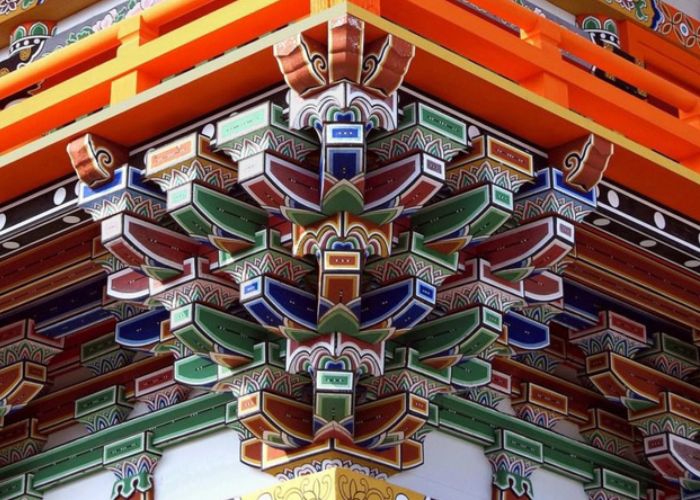 The main gate of the Forbidden City is Jiufen Gate, a large gate with three main entrances. It is protected by staircases and walls, creating an impressive symbol of the palace. The buildings in the Forbidden City are built along a symmetrical axis, creating a perfect landscape and absolute balance. The buildings are highly structured, with square roofs and exquisite architectural details.
The main gate of the Forbidden City is Jiufen Gate, a large gate with three main entrances. It is protected by staircases and walls, creating an impressive symbol of the palace. The buildings in the Forbidden City are built along a symmetrical axis, creating a perfect landscape and absolute balance. The buildings are highly structured, with square roofs and exquisite architectural details.
The Forbidden City has many important main buildings such as the Central Palace, Main Palace, Royal Palace and Thai Hoa Palace. Each building has a tall architectural structure and is built in traditional Chinese style.
The Central Palace is the largest building and located in the center of the Forbidden City. It is considered the heart of the palace, a place to organize important events and welcome VIP guests. The Main Palace is where the emperor resides. It has a majestic architecture with floors and square roofs covered with yellow tiles, symbolizing power and wealth. The Royal Palace is the living place of the queen and her concubines. It is decorated with works of art and precious artifacts, creating a solemn and classy space. Thai Hoa Palace is where important ceremonies such as the emperor's inauguration ceremony and press conferences are held. It has a large ceremony room with exquisitely decorated columns and ceilings.
The architecture of the Forbidden City also shows ingenuity in the use of color. The buildings are decorated with vibrant colors such as red, yellow, green and white, symbolizing the wealth and power of the dynasty. The architecture of the Forbidden City is decorated with intricate details such as engraved patterns, motifs and sculptures. These details are often meticulously crafted and symbolic with cultural and historical significance.
The main colors of the Forbidden City are red, green and white, symbolizing wealth, power and the traditional spirit of the dynasty. The square roofs on the buildings are covered with yellow tiles, creating a beautiful image and typical of Chinese architecture.
The Hall of Supreme Harmony is one of the most prominent and important palaces in the Forbidden City. It is located at the center of the palace and is considered a symbol of the power and magnificence of the Chinese court. The Central Palace has majestic architecture and is the place where important events and royal ceremonies are held.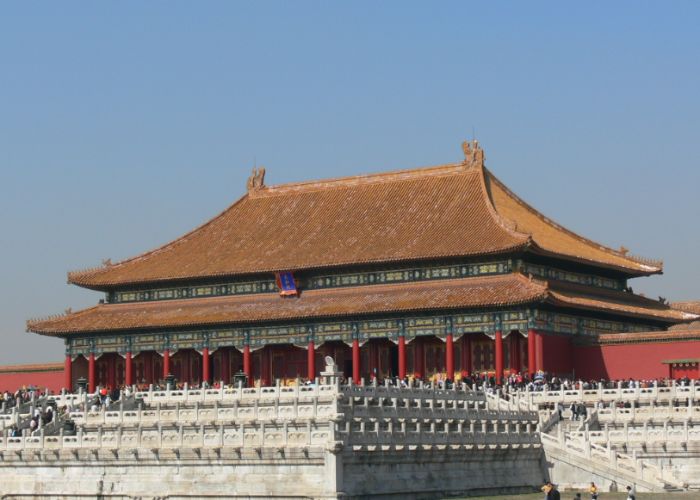 The Central Palace has a large rectangular shape. It stands out with three main doors opening to the south, north and west. The main doors are protected by stairs and surrounding walls. The building is built on a high foundation, creating solidity and stability. Inside, there are three floors with large rooms and important ceremony rooms.
The Central Palace has a large rectangular shape. It stands out with three main doors opening to the south, north and west. The main doors are protected by stairs and surrounding walls. The building is built on a high foundation, creating solidity and stability. Inside, there are three floors with large rooms and important ceremony rooms.
The ceremony room in the Central Palace is a large and solemn space. On the ceiling, there are intricate decorations and exquisite motifs, demonstrating the sophistication of Chinese arts and crafts. The columns are also decorated with unique artistic details.
The Central Palace was used for important events in the court such as the emperor's inauguration ceremony, attendant ceremonies and welcoming VIP guests. This is where the most important rituals and ceremonies of the Chinese court take place. The architecture and central position of the Central Palace also demonstrate the power of the emperor and the importance of the throne.
The Central Palace in the Forbidden City is not only a beautiful architectural work but also an important symbol of Chinese culture and history. It is one of the places that attracts a large number of tourists, allowing them to enjoy the beauty and profound significance of the traditional royal palace.
Hall of Central Harmony is one of the important palaces in the Forbidden City. Located between the Central Palace and the Imperial Palace, the Main Palace plays an important role in the activities of the Chinese court. This is where the emperor resides and prepares for important royal ceremonies.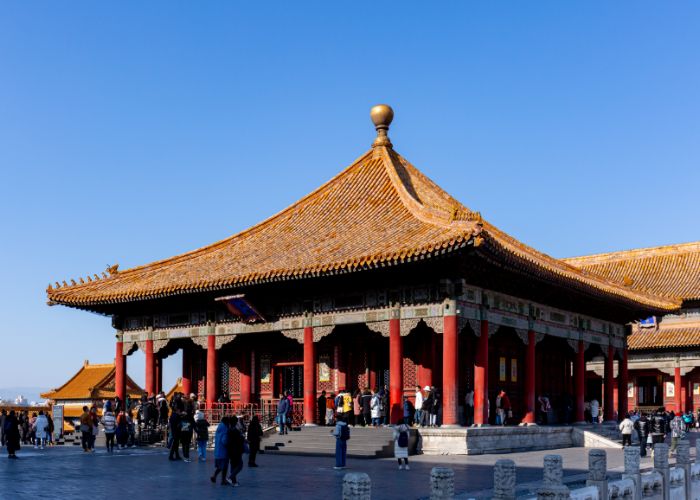 The Main Palace has unique architecture and is built on a high foundation. The palace is rectangular with square roofs and floors. The main door of the Main Palace opens to the south and is protected by stairs and surrounding walls. Inside, the Main Palace has administrative rooms and the emperor's office. It is delicately decorated with traditional Chinese artistic motifs and details.
The Main Palace has unique architecture and is built on a high foundation. The palace is rectangular with square roofs and floors. The main door of the Main Palace opens to the south and is protected by stairs and surrounding walls. Inside, the Main Palace has administrative rooms and the emperor's office. It is delicately decorated with traditional Chinese artistic motifs and details.
The Main Palace is where the emperor conducts meetings and prepares for important royal ceremonies such as year-end ceremonies and spring ceremonies. The Emperor used the Main Palace to discuss with high-ranking officials and make important decisions for the court. The Main Palace is also where the emperor resides during royal ceremonies or special events
The Main Palace in the Forbidden City is an indispensable part of the palace's architectural landscape. It displays the solemnity and majesty of the Chinese imperial court and gives visitors an insight into the life and activities of the emperor in the past
.

















































